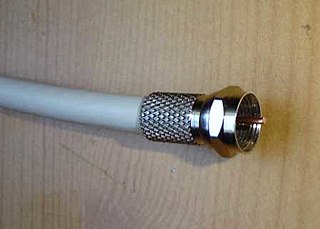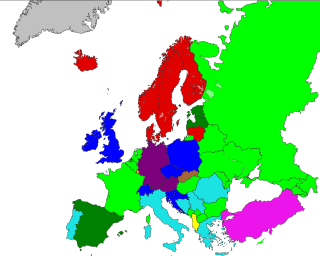
Cable television is a system of delivering television programming to consumers via radio frequency (RF) signals transmitted through coaxial cables, or in more recent systems, light pulses through fibre-optic cables. This contrasts with broadcast television, in which the television signal is transmitted over-the-air by radio waves and received by a television antenna attached to the television; or satellite television, in which the television signal is transmitted over-the-air by radio waves from a communications satellite orbiting the Earth, and received by a satellite dish antenna on the roof. FM radio programming, high-speed Internet, telephone services, and similar non-television services may also be provided through these cables. Analog television was standard in the 20th century, but since the 2000s, cable systems have been upgraded to digital cable operation.

A television licence or broadcast receiving licence is a payment required in many countries for the reception of television broadcasts, or the possession of a television set where some broadcasts are funded in full or in part by the licence fee paid. The fee is sometimes also required to own a radio or receive radio broadcasts. A TV licence is therefore effectively a hypothecated tax for the purpose of funding public broadcasting, thus allowing public broadcasters to transmit television programmes without, or with only supplemental, funding from radio and television advertisements. However, in some cases the balance between public funding and advertisements is the opposite – the Polish broadcaster TVP receives more funds from advertisements than from its TV tax.

The Telecommunications Act of 1996 was the first significant overhaul of United States telecommunications law in more than sixty years, amending the Communications Act of 1934. The Act, signed by President Bill Clinton, represented a major change in American telecommunication law, since it was the first time that the Internet was included in broadcasting and spectrum allotment.
Public-access television is traditionally a form of non-commercial mass media where the general public can create content television programming which is narrowcast through cable television specialty channels. Public-access television was created in the United States between 1969 and 1971 by the Federal Communications Commission (FCC), under Chairman Dean Burch, based on pioneering work and advocacy of George Stoney, Red Burns, and Sidney Dean.
In cable television, governments apply a must-carry regulation stating that locally licensed television stations must be carried on a cable provider's system.

Mediacom Communications Corporation is the United States' fifth largest cable television provider based on the number of video subscribers, and among the leading cable operators focused on serving smaller cities and towns. The company has a significant concentration of customers in the Midwest and Southeast, and is the largest broadband provider in Iowa. Founded in 1995 by Rocco B. Commisso, the current owner of the New York Cosmos and ACF Fiorentina. Mediacom is headquartered in New York and incorporated in Delaware, United States. Formerly a publicly traded firm, it went private in a $600 million transaction in March 2011 and is owned solely by Commisso as of 2011.

Comcast Cable Communications, LLC, doing business as Xfinity is a telecommunications company and division of Comcast Corporation used to market consumer cable television, internet, telephone, and wireless services provided by the company. The brand was first introduced in 2010; prior to that, these services were marketed primarily under the Comcast name.

The Cable Communications Policy Act of 1984 was an act of Congress passed on October 30, 1984 to promote competition and deregulate the cable television industry. The act established a national policy for the regulation of cable television communications by federal, state, and local authorities. Conservative Senator Barry Goldwater of Arizona wrote and supported the act, which amended the Communications Act of 1934 with the insertion of "Title VI—Cable Communications". After more than three years of debate, six provisions were enacted to represent the intricate compromise between cable operators and municipalities.
Suddenlink Communications is an American telecommunications subsidiary of Altice USA trading in cable television, broadband, IP telephony, home security, and advertising. Prior to its acquisition by Altice, the company was the seventh largest cable operator with 1.5 million residential and 90,000 business subscribers. After Altice acquired Cablevision Systems Corporation on November 30, 2016, Suddenlink was combined with Cablevision. Together with Optimum - the name used by Cablevision for its products - Altice USA became the United States' fourth largest cable operator with 4.6 million subscribers, and the sixth largest Pay TV service provider with 3.50 million subscribers.
Cable television first became available in the United States in 1948. By 1989, 53 million U.S. households received cable television subscriptions, with 60 percent of all U.S. households doing so in 1992. with Data by SNL Kagan shows that as of 2006 about 58.4% of all American homes subscribe to basic cable television services. Most cable viewers in the U.S. reside in the suburbs and tend to be middle class; cable television is less common in low income, urban, and rural areas.

Government-access television (GATV) is a type of specialty television channel created by government entities and broadcast over cable TV systems or, in some cases, over-the-air broadcast television stations. GATV programming generally deals with public affairs, board meetings, explanation of government services, and other public-service related programming such as public service announcements and longer public information films.
A local franchise authority (LFA) is a United States local government organization that, together with the Federal Communications Commission (FCC), regulates cable television service within the local government's area. In some cases the LFA is the state, while in others it might be a city, county, or municipality. The LFA is meant to address cable problems such as service related rates and charges, tier rates, customer service problems, franchise fees, signal quality, and the use of public, educational, and governmental (PEG) channels. When experiencing a problem with your cable television you should first contact the cable company itself, then the local franchise authorities, then the National Citizens Committee for Broadcasting, and finally the chairmen of the House and Senate subcommittees who oversee the FCC. Additional help can be found on the web page of the Federal Communications Commission.
York Community Access Television (YCAT) was a Public-access television cable TV station in York, Pennsylvania.
Rob Briley is an American politician and a Democratic former member of the Tennessee House of Representatives for the 52nd district, which is part of Davidson County. He is the brother of Nashville politician David Briley and the grandson of Beverly Briley, Metro-Nashville's first mayor.
Multichannel television in the United States has been available since at least 1948. The United States is served by multichannel television through cable television systems, direct-broadcast satellite providers, and various other wireline video providers; among the largest television providers in the U.S. are AT&T, Altice USA, Charter Communications, Comcast, Dish Network, and Verizon Communications. The Telecommunications Act of 1996 defines a multichannel video programming distributor (MVPD) as "a person such as, but not limited to, a cable operator, a multichannel multipoint distribution service, a direct broadcast satellite service, or a television receive-only satellite program distributor, who makes available for purchase, by subscribers or customers, multiple channels of video programming", where a channel is defined as a "signaling path provided by a cable television system."
Fee-for-carriage, value-for-signal, negotiation for value, or the "TV tax" all refer to a proposed Canadian television regulatory policy which would require cable and satellite television companies to compensate conventional, over-the-air television stations for the right to carry their local signals. Such a system has long existed in the United States, under the name of retransmission consent.

The Cable Television Consumer Protection and Competition Act of 1992 is a United States federal law which required cable television systems to carry most local broadcast television channels and prohibited cable operators from charging local broadcasters to carry their signal.

Sky Cable Corporation, doing business as Sky, is a Filipino telecommunications company based in Diliman, Quezon City. A subsidiary of the media conglomerate ABS-CBN, the company offers broadband, cable and satellite television services under the Sky Cable and Sky Direct brands. The company was founded on June 6, 1990 by Benpres Holdings Corporation as Central CATV, Inc.
A carriage dispute is a disagreement over the right to "carry", that is, retransmit, a broadcaster's signal. Carriage disputes first occurred between broadcasters and cable companies and now include direct broadcast satellite and other multichannel video programming distributors.
Communications law refers to the regulation of electronic communications by wire or radio. It encompasses regulations governing broadcasting, telephone and telecommunications service, cable television, satellite communications, wireless telecommunications, and the Internet.






